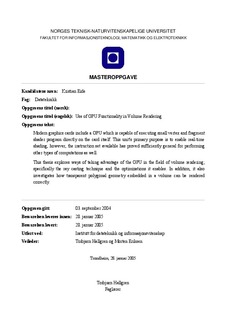Use of GPU Functionality in Volume Rendering
Master thesis
Permanent lenke
http://hdl.handle.net/11250/251040Utgivelsesdato
2005Metadata
Vis full innførselSamlinger
Sammendrag
Volume rendering describes the processes of creating a 2D projection of a 3D discretely sampled data set. This field has a number of applications, most notably within medical imaging, where the output of CT and MRI scanners is a volume data set, as well as geology where seismic surveys are visualized as an aid when searching for oil & gas. Rendering a volume is a computationally intensive task due to the large amount of data that needs to be processed, and it is only recently, with the advent of commodity 3D accelerator cards, that interactive rendering of volumes has become possible. The latest versions of 3D graphics cards include a Graphics Processing Unit, or GPU, which is capable of executing small code fragments at very high speed. These small programs, while not as flexible as traditional programming, still represent a significant improvement in what is possible to achieve with the added computational ability provided by the graphics card. This thesis explores how volume rendering can be enhanced by the use of a GPU. In particular, it shows an improvement to the GPU-based raycasting approach presented in [1] and also a method for integrating the depth peeling technique [6] with a volume renderer for correctly rendering transparent geometry embedded in the volume. In addition, an introduction to volume rendering and GPU programming is given, and a rendering of a volume with the Phong illumination model is shown.
